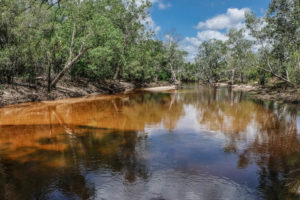2 August 2018
The Ranger uranium mine is due to cease operations in 2021 and the site will be rehabilitated by 2026. Knowledge on how saline plumes of water from the weathering of mine waste rock might affect ecological processes and connectivity in Magela Creek, adjacent to the mine site, will inform potential long-term risks to the environment and mine rehabilitation options. A new Hub research project led by Associate Professor David Crook of Charles Darwin University and partnering with the Department of the Environment and Energy’s Supervising Scientist Branch is investigating the extent to which plumes of magnesium sulfate (a salt) in Magela Creek from mine waste rock could interfere with the migrations of native fish populations, which need to be able to move between the river, floodplain and escarpment country upstream and downstream of the mine site.
A/Prof Crook headed to the USA last week to begin his Fulbright Professional Scholarship with the Woods Hole Oceanographic Institute in Massachusetts, and Oregon State University and the US Forest Service in Oregon. He’ll be undertaking collaborative research into tropical (barramundi) and temperate (salmon) fish migrations—movements which are critical to maintaining ecosystem connectivity and sustainable fisheries management.

Magela Creek in Kakadu. Photo: Supervising Scientist Branch (Commonwealth of Australia).
Want to know more about the Resilient Landscapes Hub's activities and our research into practical solutions to environmental problems? Stay informed about activities, research, publications, events and more through the Hub newsletter.